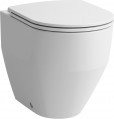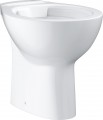Functions
Among the basic functions of the toilet, one can single out
circular flush of water in the bowl,
half flush,
antibacterial coating, anti-
splash, micro-lift of the
seat. More about them:
— Vortex flush (in the bowl). In toilets with a vortex flush, water flows from holes under the rim and sequentially washes the entire bowl through the formation of a characteristic water vortex. Jets of water can be directed from the outlets straight or at a slight angle: the first option is called swirling, the second – shower. The advantages of a vortex flush are low water consumption, high-quality cleaning of the toilet, absence of splashes and minimal noise levels. However, sanitary equipment with such a flush system are often more expensive than traditional solutions.
- Half drain. The ability to drain from the tank not all the water, but only a part, usually half (hence the name). It is due to the fact that a complete drain is not always required - for example, half a tank is enough to flush urine even in toilet bowls with a plate bowl (see "Bowl Shape"). This function will be useful primarily for those for whom water saving is critical (for example, if meters are installed in the apartment).
- Anti-splash. The anti-splash system prevents water splashing on the sides when the water is drained
...from the tank. Anti-splash toilets have a special bowl design. In them, the bowl is inclined, the water flowing down the inclined plane from the tank immediately goes into the sewer drain. The "anti-splash" function allows you to increase the level of hygiene and sanitation in the restroom. Toilets with an anti-drain system also have disadvantages. The main disadvantage of such models is the increased water consumption.
— Seat microlift. A device that prevents the toilet seat from hitting the rim of the bowl. It works similar to door closers: the movement of the seat is slowed down, slowing down as much as possible when approaching the rim, which ensures soft contact, prevents unpleasant popping and protects the seat and rim from damage and wear. In addition, the microlift provides additional convenience - you just need to push the seat, and it will lower itself.In box
Additional items supplied with toilet bowl.
—
Drain tank. The tank in which the water is stored for drainage. By definition comes complete with toilet comps (see. «Type»), although some of these models may have the option «without tank». But the traditional toilet bowls are very rarely sold immediately with a tank for plumbing - it is believed that this element of design in such cases is more convenient to choose separately.
—
Seat with cover. A seat for comfortable placement on the toilet, supplemented by a lid that covers the bowl in «non-working time» and keeps unpleasant odors and harmful microorganisms inside. Both seats and covers are sold separately, but it is more convenient (and sometimes cheaper) to buy them together with the toilet. Especially this configuration can be useful when buying products of non-standard form, to which it is difficult to choose third party accessories.
Weight
The total weight of the product; for compact-toilet (cf. «Type»), as a rule, is specified for standard equipment - together with «native» tank (empty).
When choosing floor models on this indicator you can not pay much attention, but for a hanging toilet bowl (see. «Installation») weight is quite principial: because the installation (or other attachment) should normally withstand both the design and the user sitting on it.
Bowl height
The height of the toilet bowl, namely the upper edge of the bowl.
In floor models (cf. «Installation») this size is considered from the base, in suspended - from the bottom edge. It should be borne in mind that hanging articles are usually set at a height of at least 5 - 10 cm above the floor, so the actual height of the bowl will be greater by the appropriate amount. Flooring models are usually placed at the floor level, and the actual height of the bowl in them corresponds to the stated (theoretically it is possible to adjust this height by installing the toilet at an elevation or recess, but in practice it is easier to choose the model of the desired height).
The lowest height values -
up to 30 cm inclusive - can be found exclusively in hanging toilets (this is not inconvenient given the features of installation). The same type of installation applies to most models on
31 - 34 cm and
35 - 37 cm, although these categories already include floor products. However, among the latter, the most popular height -
38 - 40 cm, is also very common outdoor toilet bowls height
more than 40 cm (in suspended models the height is higher than 38 cm and rare).
Regarding the choice of this parameter, it is worth considering the use of the toilet. Thus, for public use, the best option is considere
...d to be the actual height of the bowl of 40 - 44 cm; this height is clearly prescribed in some sanitary standards, it is convenient for most adults and is quite acceptable for children (except for the smallest, who already require the help of an adult when using the toilet). But for personal use, the toilet should be selected more carefully, and here may be suitable values. The general rule is that, ideally, the legs of a seated person should be bent at a right angle and freely stand on the floor without hanging or straining themselves beyond measure. However, people in the family may differ markedly in stature and needs. In general, therefore, it is recommended to take into account the growth of the highest family member and, in the case of a person with special needs, those needs first.Dimensions (HxWxD)
General dimensions of the toilet bowl in height, width and depth (by depth is meant the distance from the front edge to the rear edge).
These indicators allow you to determine how much space is required to install the product, and also affect some practical points. In this case, width and depth are of key importance. Specific figures and nuances for these dimensions are as follows:
- Width:
up to 35 cm in the narrowest models,
40 cm or more in the widest, intermediate options -
36 - 37 cm and
38 - 39 cm. A large width is desirable if people of large build will use the toilet. However, it should be borne in mind that this dimensions is indicated by the widest part of the structure, and this is not necessarily a bowl - we can talk about a tank.
- Depth:
up to 50 cm - is considered small, in the largest products -
more than 65 cm ; intermediate options include
51 - 55 cm,
56 - 60 cm and
61 - 65 cm. Here the choice depends on the height and physique of the user: tall people and people with long legs will be most comfortable with toilets with great depth.
Height is worth mentioning. In models without a tank, it corresponds to the height of the bowl
..., see more about this indicator above. In compact toilets (see "Type"), the height with the tank is usually indicated, it depends on how much vertical space is required for installation. Here, an indicator of 75 cm or less is considered small, 76 - 80 cm is average, 81 - 85 cm is above average, and for the highest products, more than 85 cm of free space above the floor will be required.Country of origin
The country of origin of the brand under which the toilet is marketed. Nowadays, on sale you can mainly find products from such countries (in alphabetical order):
Belgium,
Germany,
India,
Spain,
Italy,
Poland,
Turkey,
France,
Czech Republic,
Switzerland,
Sweden,
Japan.
There are many stereotypes related to how the origin of goods from a particular country affects their quality. However, in general, these stereotypes are unfounded. Firstly, this paragraph does not indicate the actual place of manufacture of the toilet bowl, but the "homeland" of the trademark (or the location of the manufacturer's headquarters); production facilities may be located in another country. Secondly, the actual quality of the product depends not so much on geography, but on the organization of processes within a particular company. So when choosing, it is best to focus not so much on the "nationality" of the toilet, but on the overall reputation of a particular brand. And paying attention to the country of origin makes sense if you fundamentally want (or do not want) to support a manufacturer from a
...certain state.
